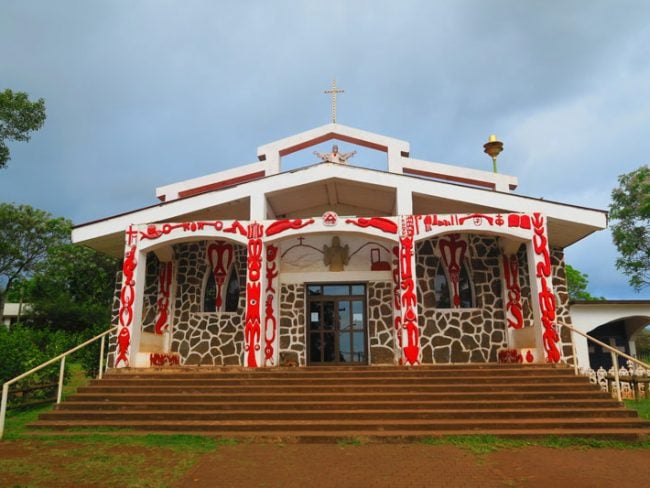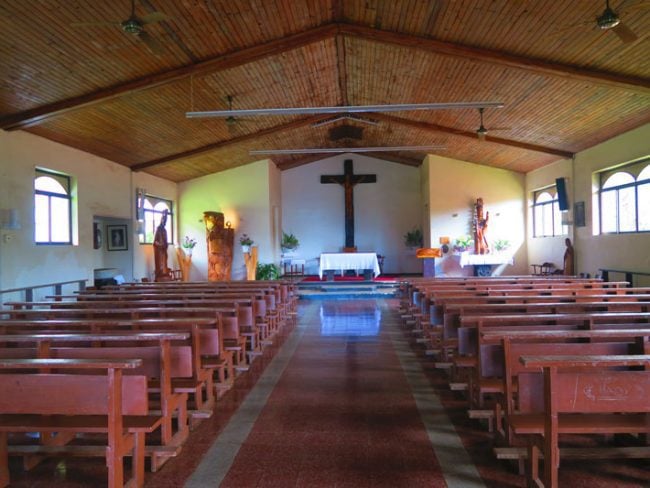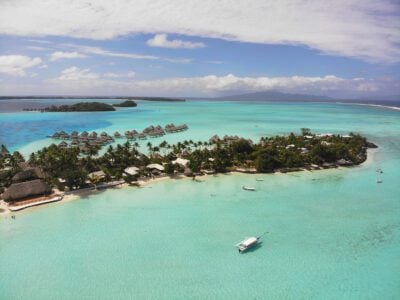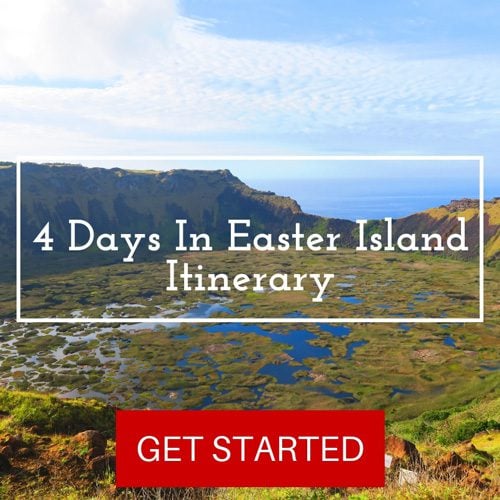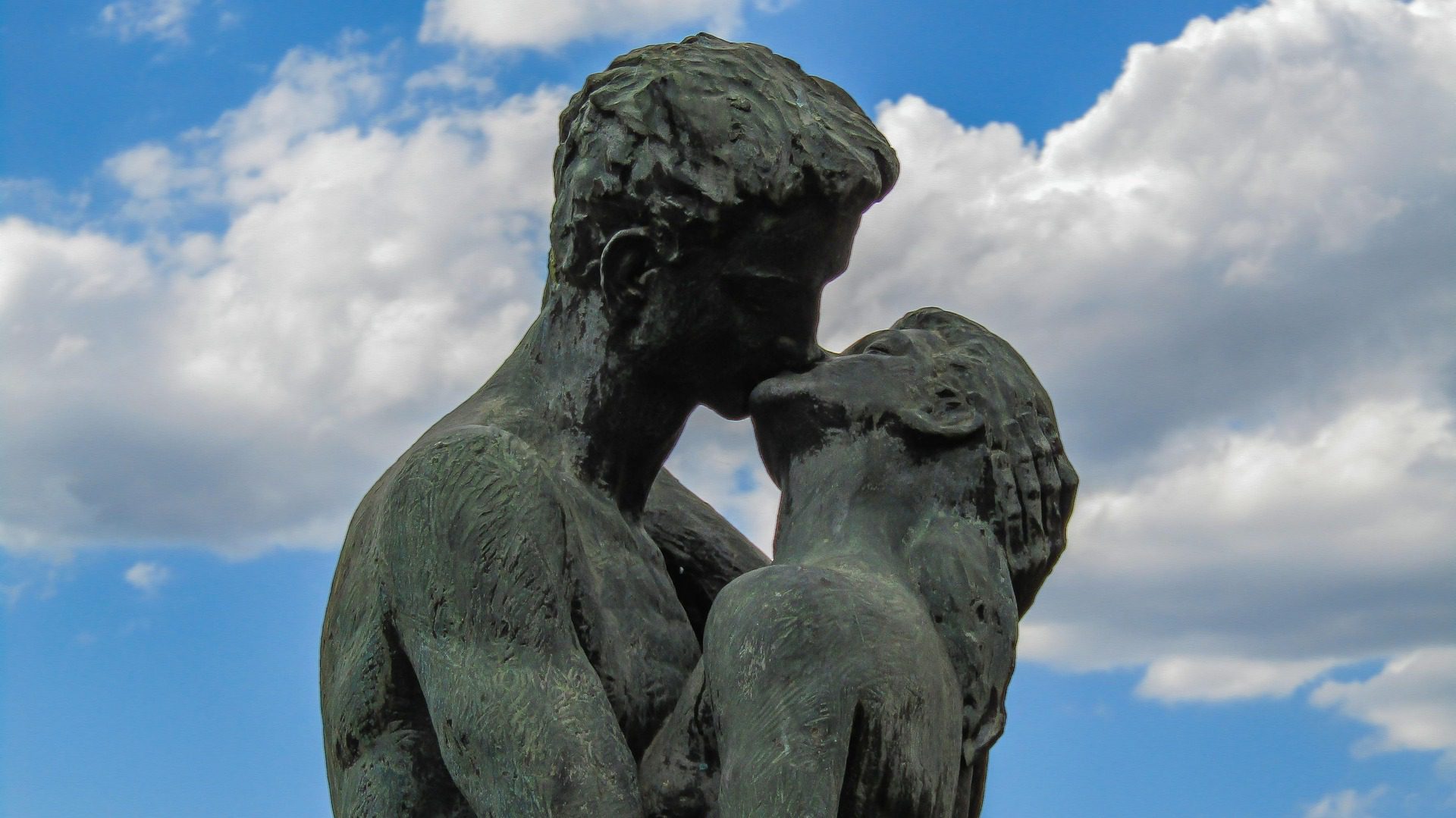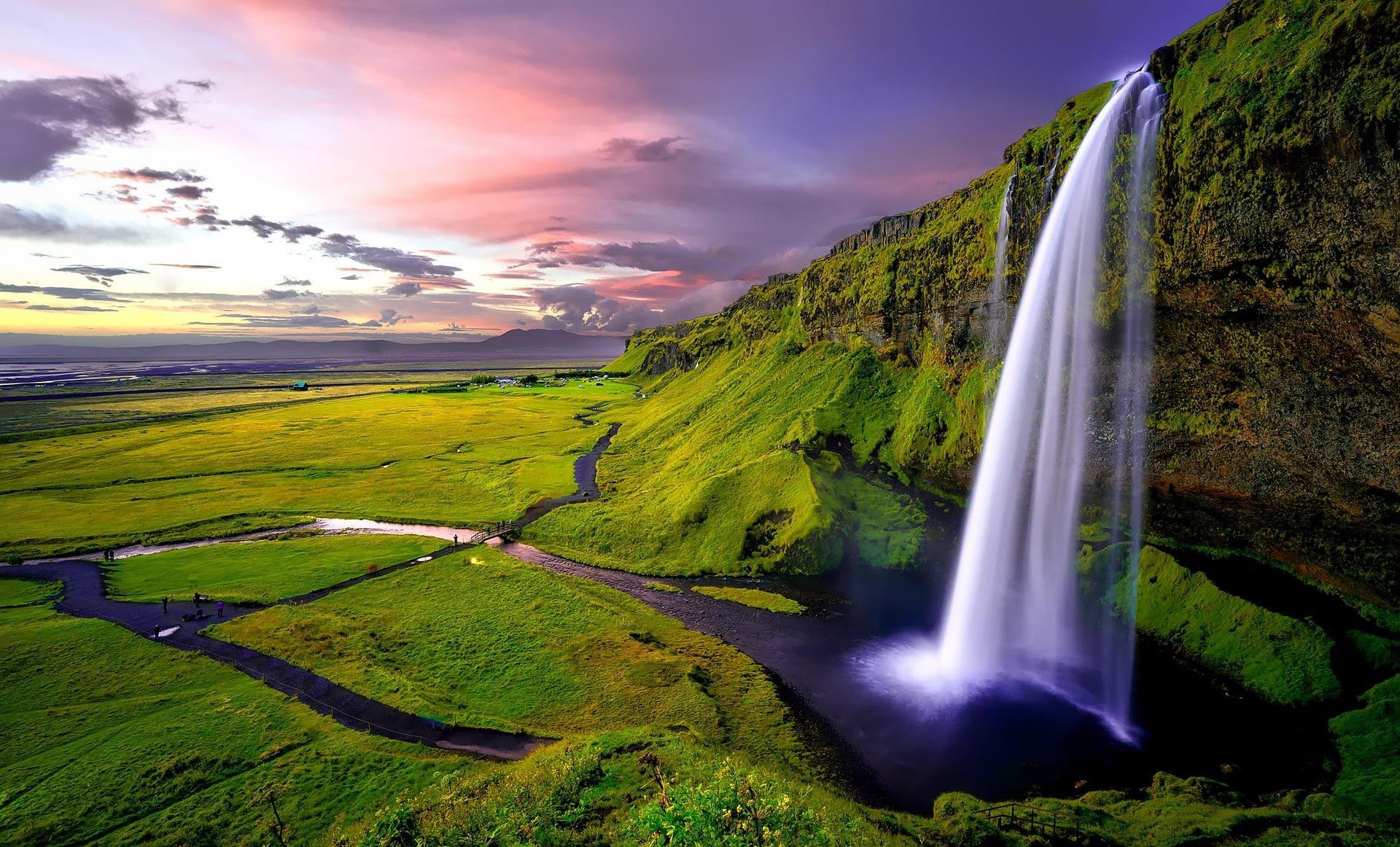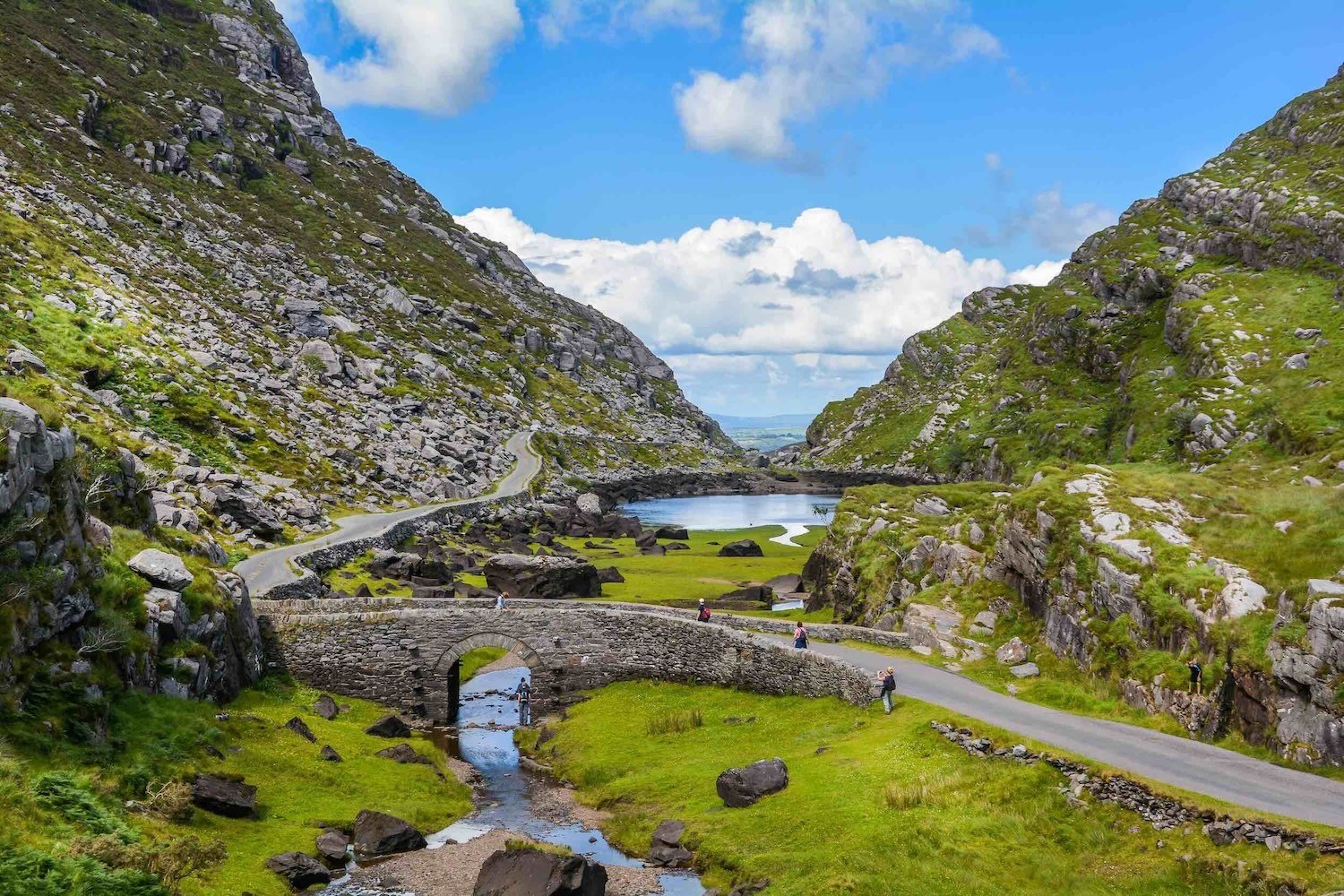Easter Island Travel Guide
Things To Do & Places To See In Easter Island
Check out these 3-day and 4-day Easter Island itineraries to see how to best divide your time on the island. If you’re looking for a quick read, here’s a list of the top 10 things to do in Easter Island.
Follow the sites mentioned in this section on this interactive map. Simply click on the image to open in Google Maps.
Hanga Roa
Home to over 90% of Easter Island’s population, Hanga Roa (meaning “wide bay”) is the closest thing to Manhattan for the next 4,000 km in either direction. I found it to be quite dull and unlively but this was after coming from Tahiti. Most of the interesting sites and businesses are located either on Te Pito o Te Henua or the more commercial Atamu Tekena. The town also boasts a few free internet hotspots but so do most restaurants and cafes.
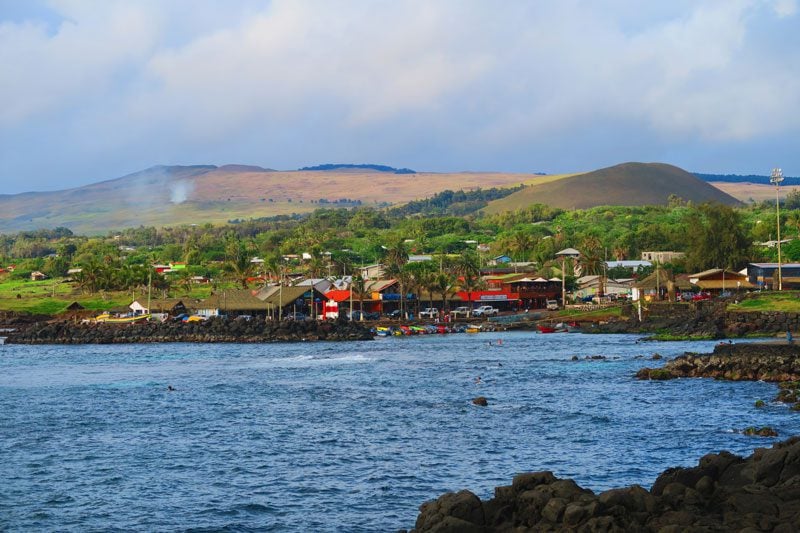


Catholic Church
Built in 1937, this is the island’s main church. While its exterior is nothing out of the ordinary, its interior does feature several exquisite wooden statues which blend both Christian and indigenous Rapa Nui symbols. Behind the church are the graves of a number of island dignitaries. If you’re here on a Sunday, do not miss the morning service which includes lots of singing and mingling with locals (arrive at around 8:30 am).
Craft Markets
Just across from the church is the main crafts market where you’ll find many stalls that basically sell the same items. Shopping will be made easy if you carry sufficient Chilean Pesos but some sellers will even accept credit cards. Should you wish to use US Dollars or Euros, sellers will do their best to accommodate you but will charge a premium. See “what to buy in Easter Island” in the previous section for the top souvenirs.
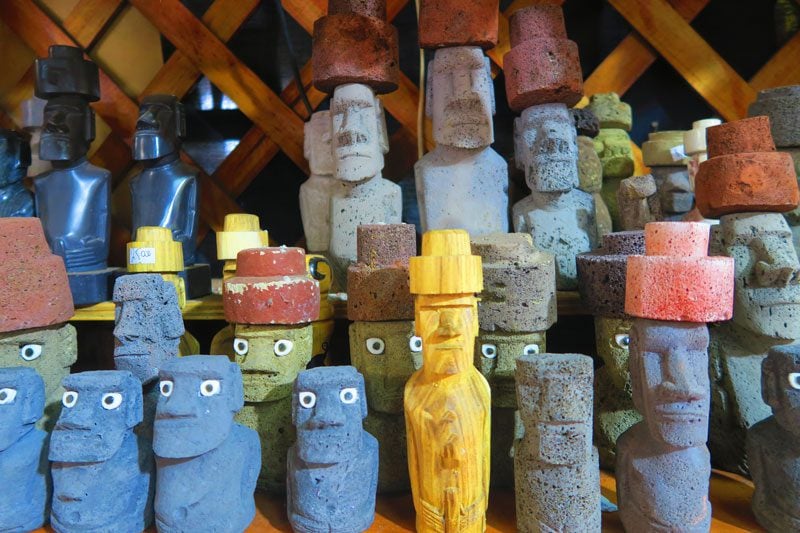
Crafts can also be purchased at the smaller (and newer) “agricultural and crafts fair” further down on Atamu Tekena. Unlike the main market, this one also sells fruits and vegetables in the back (though it’s very low-key).
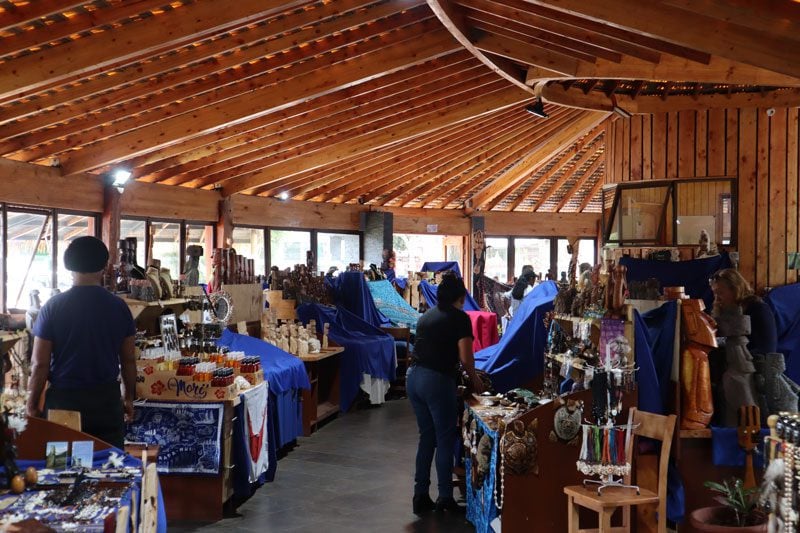
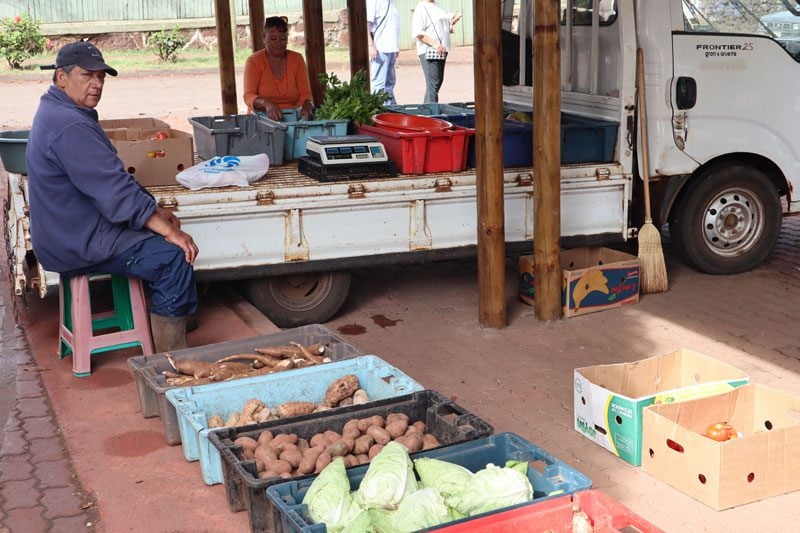
Waterfront
At the bottom of Te Pito o Te Henua is Plaza Hotu Matua and Roa Otai – the main wharf. You can snap here nice photos of the fishing boats, check out the dive centers, and grab some food/drinks in the restaurants around the wharf. If you head here in the early morning hours, you can see the fishermen returning with their fresh catch.
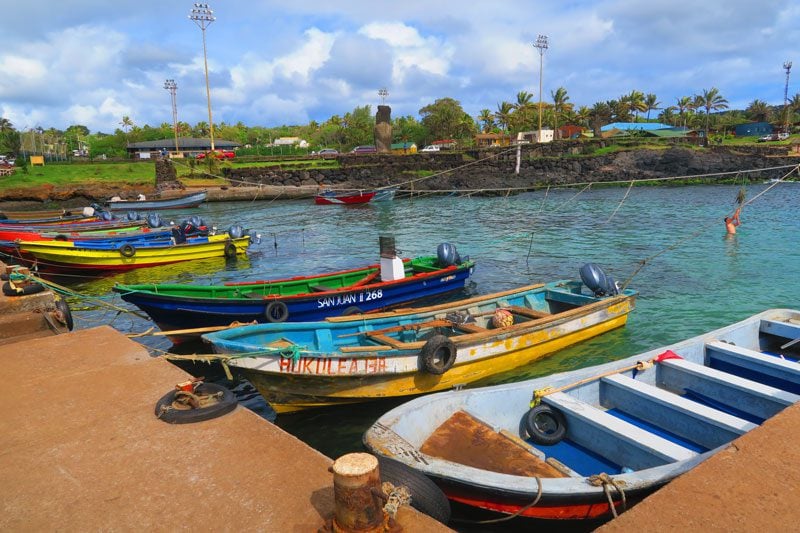

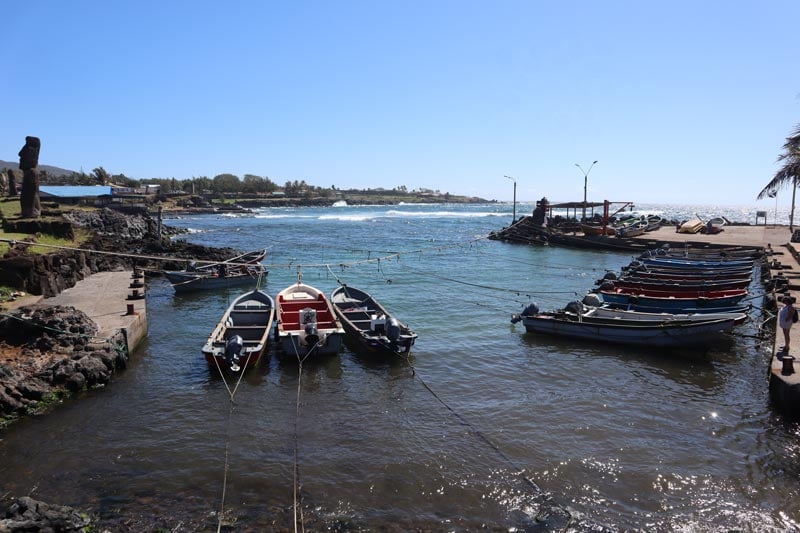
Further along the wooden boardwalk and passed the moai statue is Pea Beach – Hanga Roa’s prime bathing, surfing, and snorkeling spot. It is said that sea turtles are frequently spotted here but it wasn’t the case when I visited.
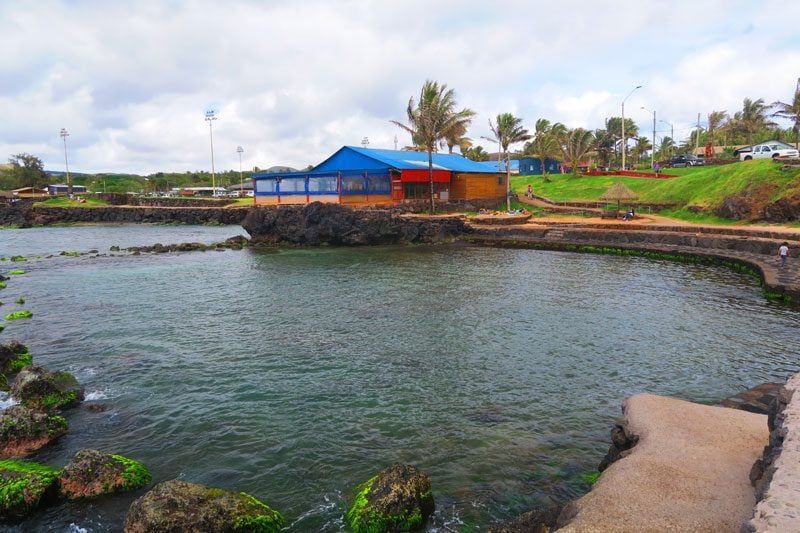
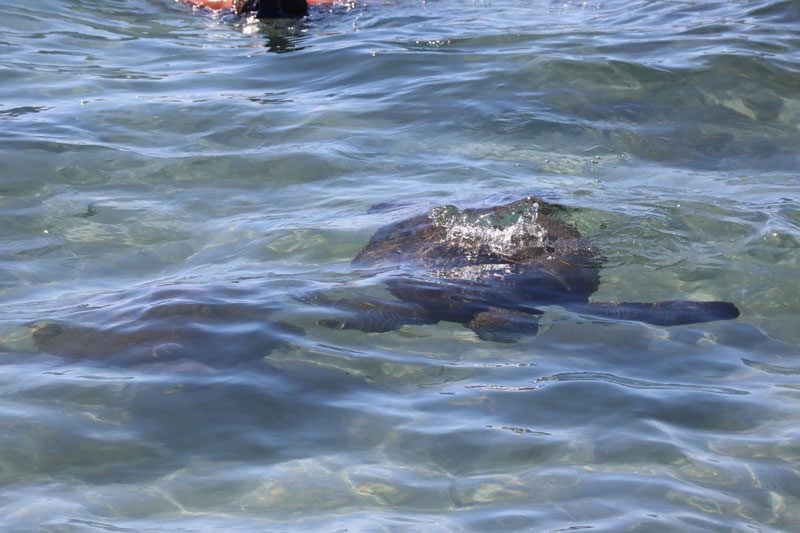
Moai Stamp in Your Passport
Visit the official Easter Island information center across the road from Pea Beach to get a unique moai stamp on your passport. This is not an official stamp by any means, but it is a great souvenir.
Hanga Vare Vare
From Plaza Hotu Matua, you can walk along the trail heading north along the coastline (in the direction of Ahu Tahai) and check out Hanga Vare Vare and its natural swimming pool plus the island’s picturesque Christian cemetery with its large cross made from a pukao – the reddish topknot adorning some of the moai.
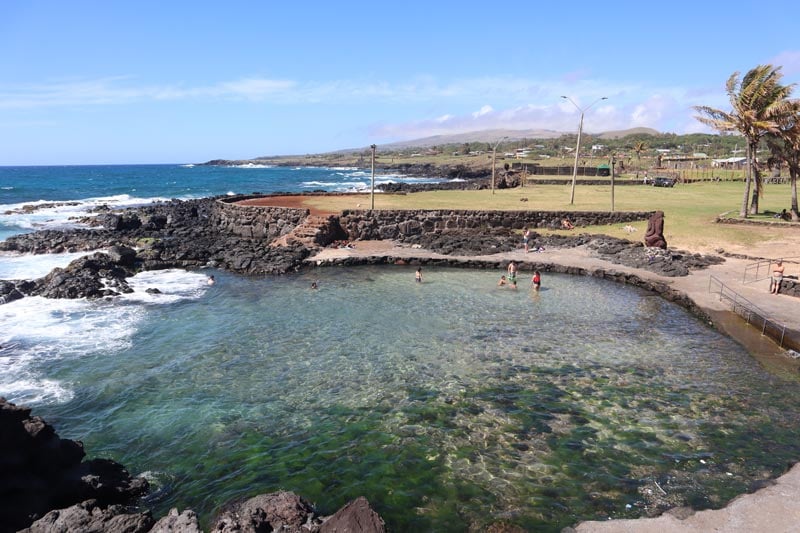

Hanga Piko
About a 15-minute walk from town, this is Easter Island’s “commercial wharf” though cargo ships cannot dock here (cargo is ferried over on smaller boats). There isn’t much to see here apart from a moai statue (Ahu Riata) and additional nice shots of colorful fishing boats (plus another dive center).

Hanga Roa Prison
Tourists can visit the island’s tiny prison and purchase discounted crafts made by the (talented) inmates themselves. Inquire locally or at the Hanga Roa police station (the prison should be right behind the station).
Cannibal Cave
Ana Kai Tangata – also known as “the cannibal cave” – is the most accessible cave from Hanga Roa. It is reached via an easy 15-minute walk from Hanga Piko or thirty minutes from downtown Hanga Roa. The setting here is simply magnificent, with cliffs smashed by ocean waves and the slopes of Rano Kau visible in the distance. There’s also a flooded lava tube that can be spotted from the bluff.
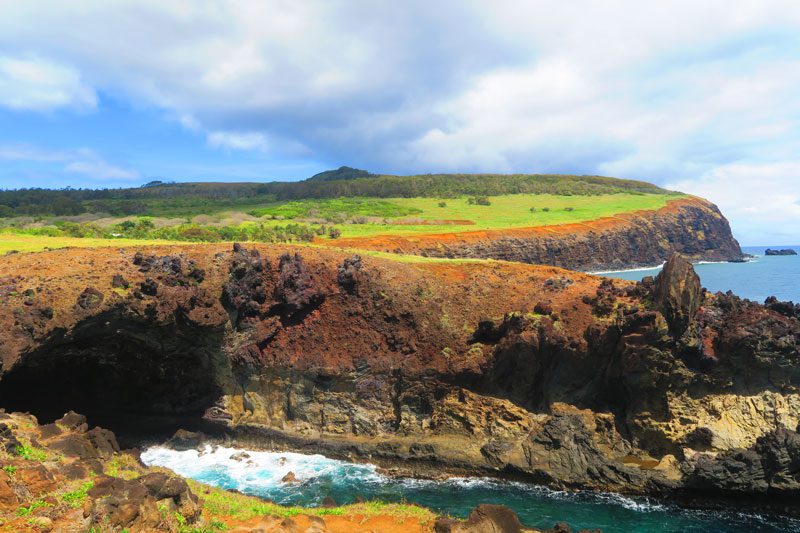
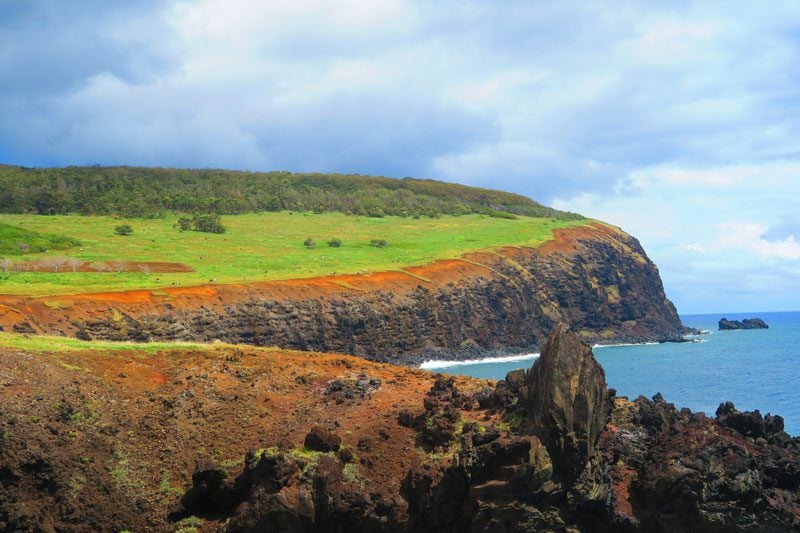
The cave is signposted and reached via a series of steps. It measures about 15 meters deep with a wide entrance and has a height of about 5 meters but you cannot venture past the railing. Painted on its ceiling are ancient petroglyphs which are a little tricky to spot but should be visible (water leaking from the upper layers and the harmful effect of sea salt are eroding the color).
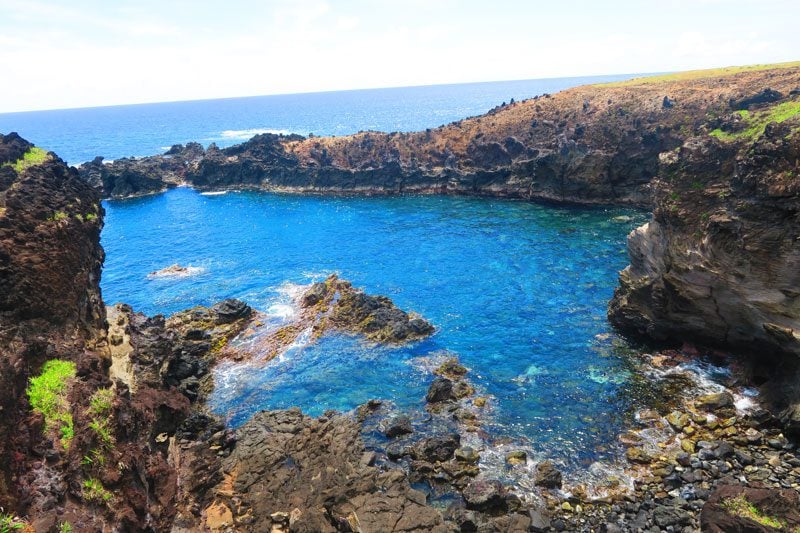
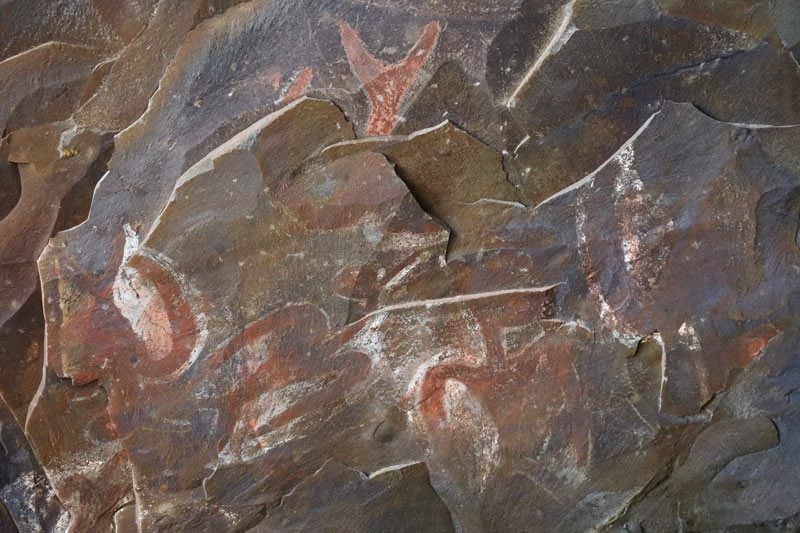

The cave’s literal translation means “man cave” but it can be interpreted in several ways which have led to it being associated with cannibalism, though no such evidence has been found. Other caves worth exploring on Easter Island are Ana Te Pora, Ana Kakenga, and Ana Te Pahu.
Ahu Tahai Complex
Ahu Tahai is easily reached by Hanga Roa either by car or by simply walking along the coastline from town. Ahu Tahai is also the best place on Easter Island for watching the sunset, as the sun gently sets on the horizon directly behind the moai statues.
Ahu Tahai is actually a series of three separate ahu: Ahu Vai Uri, Ahu Tahai, and Ahu Ko Te Riku. Ahu Vai Uri means dark or green water and its stone platform is adorned by five moai dating back to around 1200 AD. Ahu Tahai is adorned by a single moai of about 4.5 meters in height and it is the oldest ahu in the complex, dating back to 700 AD. Ahu Ko Te Riku is also adorned by a single moai but it is the only moai on Easter Island to have been fully restored with all elements, including the pukao red top knot but, more strikingly, featuring coral eyes with obsidian pupils which are thought to have embraced the moai with mana (supernatural power).
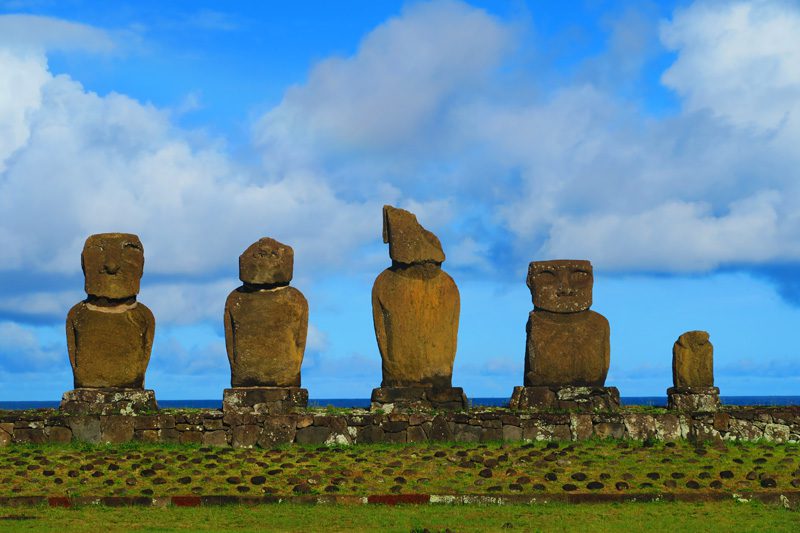

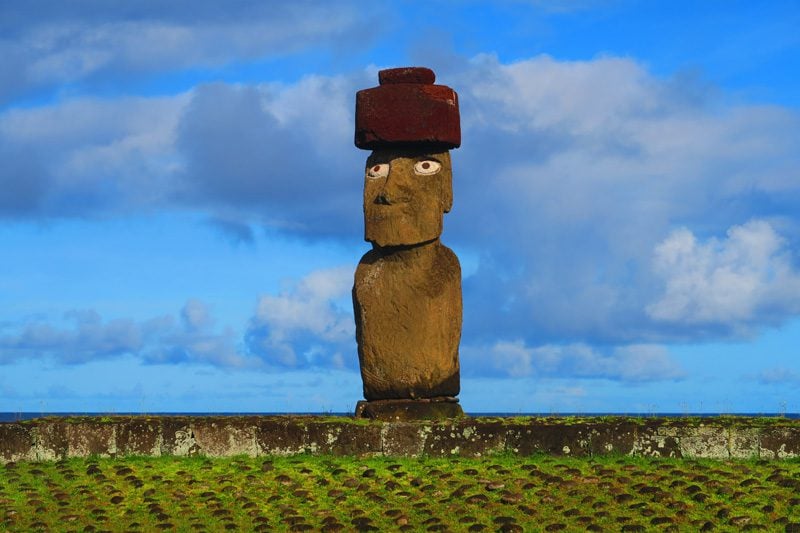


The Ahu Tahai area is actually one of the oldest settlements in Easter Island with several clues left by its Rapanui residents. As you explore the three temples, you’ll come across hare moa – stone enclosures with a small entrance used in the old days for housing chickens during the night, the stone platform of hare paenga – “classic” Rapanui homes which resembled “upside-down canoes”, and a ramp leading down to the ocean used as easy access for canoes.
Sebastian Englert Museum
This is the only museum on Easter Island and is definitely worth visiting. The museum is named after a German priest who devoted the last 34 years of his life to archeological restoration, studying the Rapanui language and its culture. Among the museum’s highlights are moai coral eyes, rongorongo tablets (not original), ancient stone tools, exquisite wood crafts, and an extremely rare female moai.


Ahu Akivi
Nearly three kilometers inland on the west coast of Easter Island, Ahu Akivi is positioned on the southern slope of Mount Terevaka and surrounded by relatively flat land that was suitable for agriculture. It is one of the 25 platforms that are not located directly on the coast and it is also one of the few ahu where the moai face out to sea. Ahu Akivi is one of the most interesting temples to visit, for its photogenic moai and for its astronomical significance.
On the platform are seven moai statues of equal shape and size, dating back to the 16th or 17th centuries – the period marking the height of moai construction on Easter Island. The seven moai are linked by some to the legend of Hotu Matua (first king) in which seven “scouts” were sent to investigate the island ahead of the challenging sea voyage.
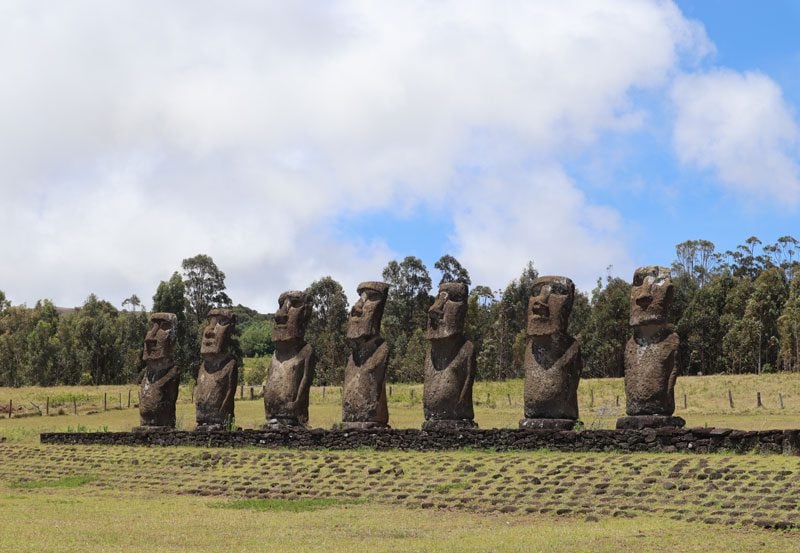
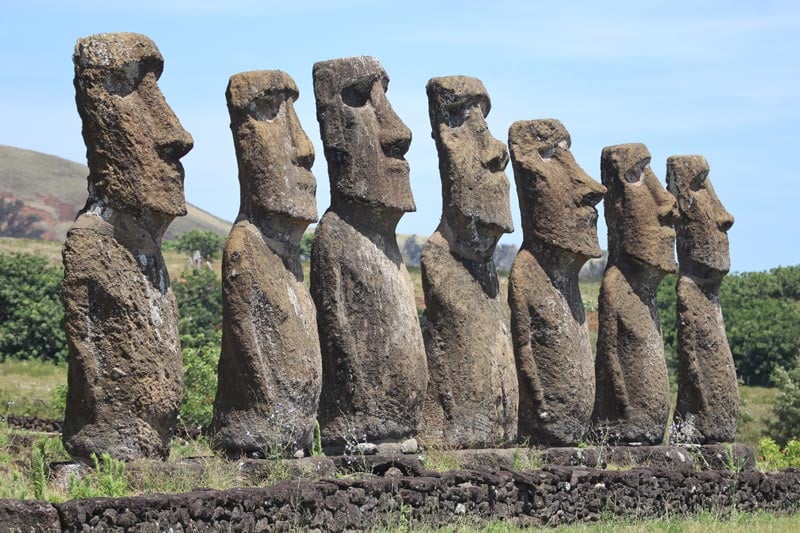

However, what is more likely is that the moai strategically (and purposely) face sunset during the spring equinox and have their backs to the sunrise during the autumn equinox. Such a precise astronomically feature by an ancient culture is remarkable and at the same time makes absolute sense considering this area was heavily populated by farmers who needed “a sign” for understanding when seasons were changing.
Puna Pau
Roughly 100 moai statues (10% of the total) were adorned with reddish topknots known as pukao. Puna Pau is the quarry from which pukao were carved. The rock found here is of unique color and its soft contents allow for relatively easy carving. The making of pukao is clear evidence of increased tribal competition since early moai did not have this feature.
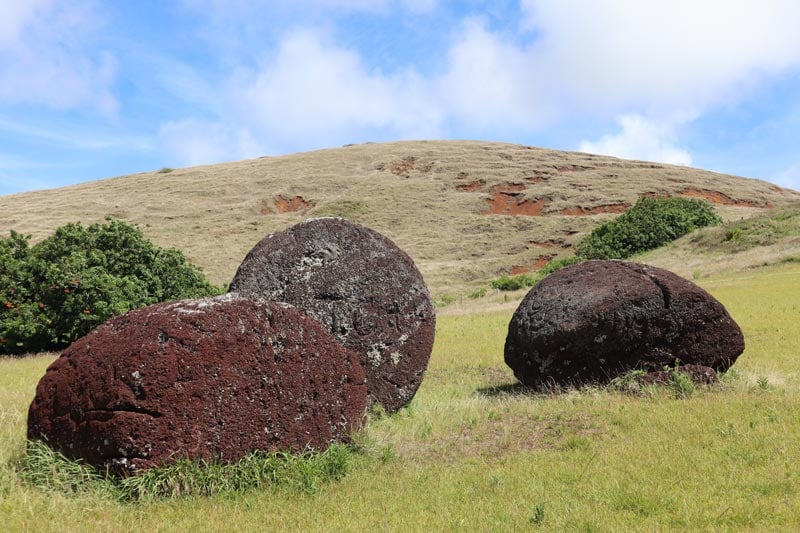

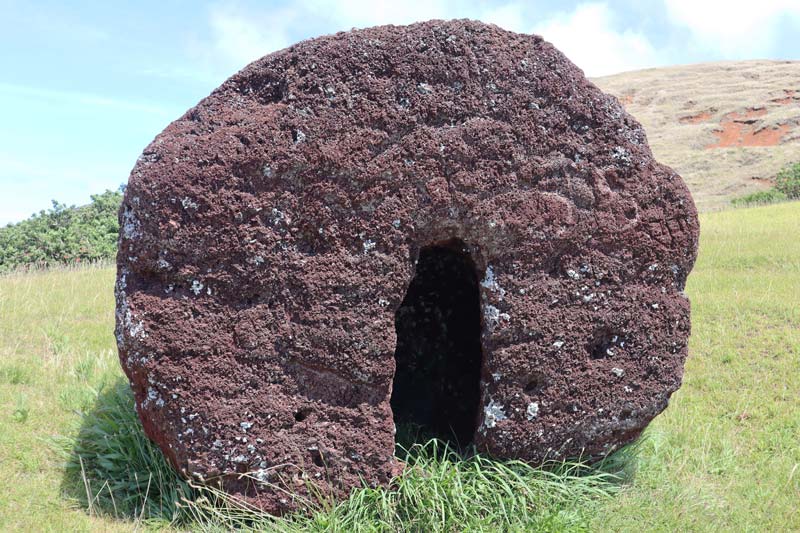
It’s important to note that the pukao do not represent a hat but rather a traditional Rapanui hairstyle of long hair tied up in a bun. The average pukao weighs about 12 tons and the largest found may have been 2.6m high and 3m wide. Locals would excavate a large chunk of rock, carve it into the shape of a ball and then transport it to its designated ahu where its final shape would be carved out.
On a clear day, the view from the top of the quarry is beautiful and you can really gather just how barren the Easter Island landscape has become and how it greatly differs from just about every island in Polynesia.
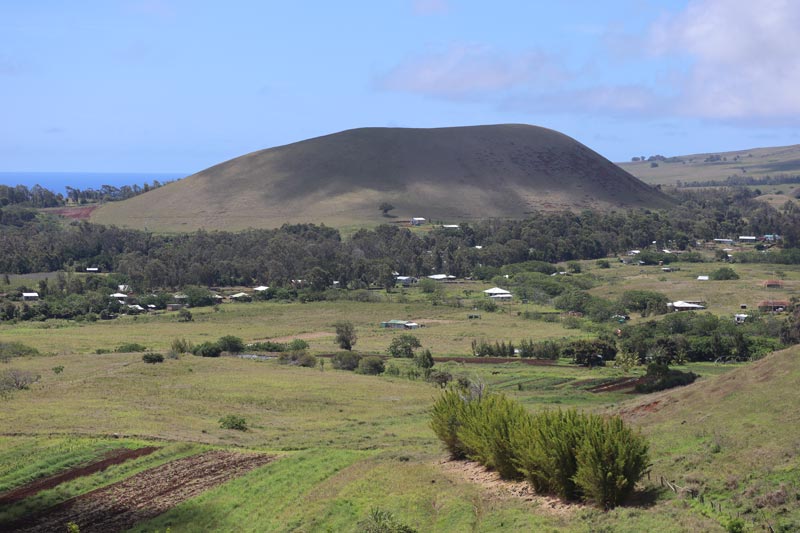

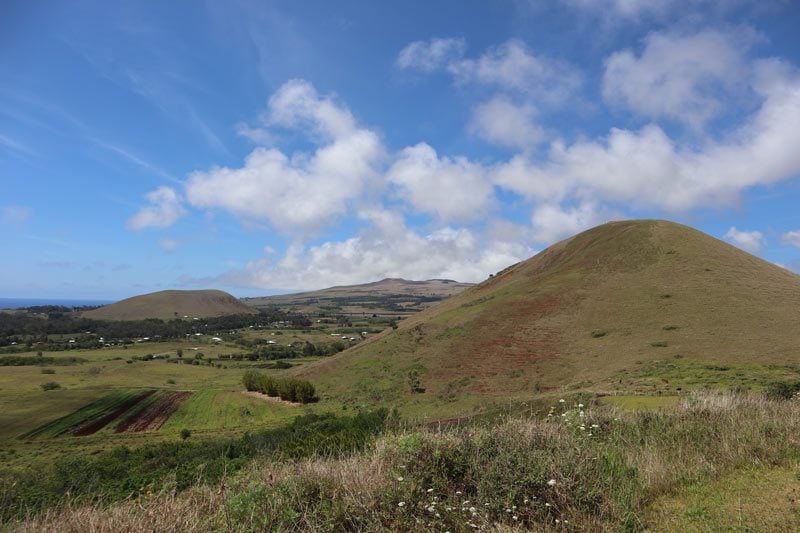
Huri a Urenga
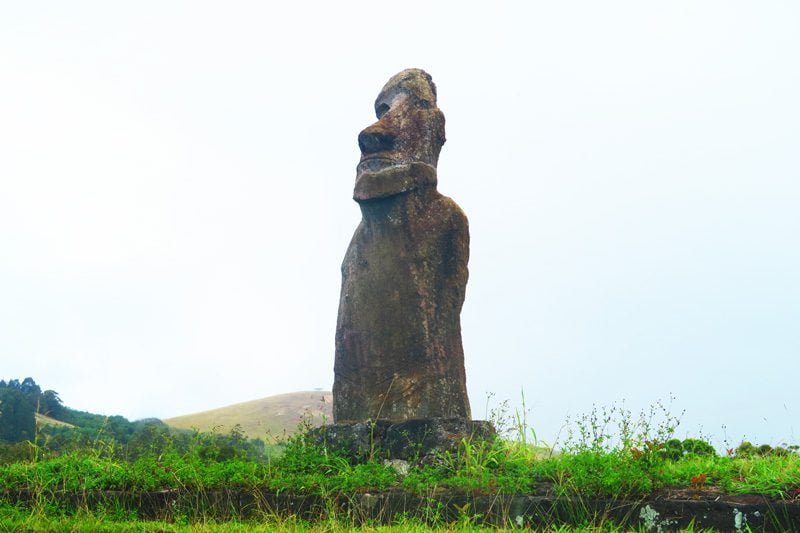
Together with Ahu Akivi, this is another inland temple. The single moai on this platform strangely features two pairs of hands, most likely the result of an error made by the original sculptures. Like the moai of Ahu Akivi, the moai of Huri a Urenga also holds astronomical significance, as the single moai faces the sun as it rises behind a hill in the winter solstice which is the shortest day of the year.
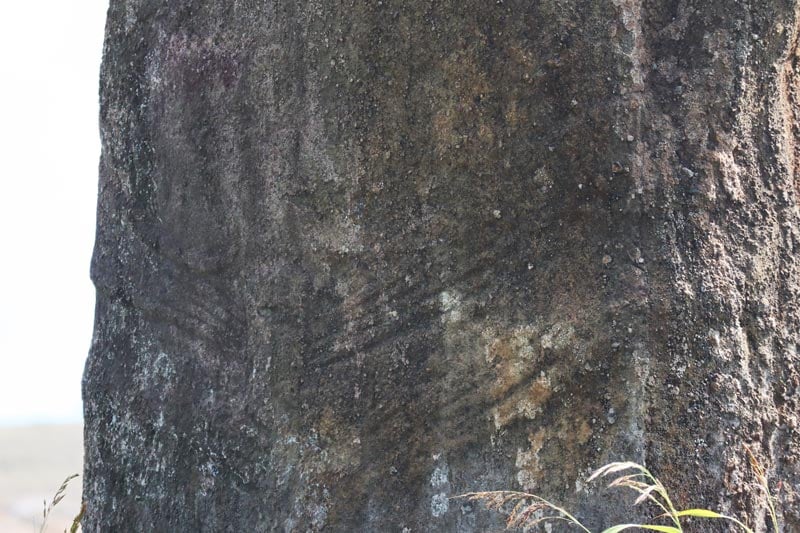
Rano Kau
Rano Kau is the most striking natural feature on Easter Island. It is a dormant volcano measuring 324 meters in height whose flooded crater measures 1.6 km in diameter with a water depth of 10 meters. The lake of Rano Kau was, therefore, an important source of fresh water to the ancient Rapanui though it must have been mighty hard to fetch it. Shielded from the ever-present wind, the crater’s interior enjoys a unique microclimate that helped form a bed of unique reeds and other plants on the surface of its lake.
The best way to appreciate Rano Kau is from the viewing area en route to Orongo Village. The views from up here are sensational and on a clear day, you can clearly see Mount Terevaka and Poike – the other two volcanos that, together with Rano Kau, give Easter Island its signature triangle shape. From the lookout, you can walk along a path that partially circles the crater rim but you cannot walk down to the lake without a certified guide.


Orongo Village
Orongo is one of two Easter Island sites that can only be visited once (your national park ticket is stamped). Orongo’s dramatic location is enough to blow your mind but the allure of the bizarre religious ritual that took place here up until 1868 is what makes this spot so unique.
It’s often very windy in Orongo Village, so pack accordingly.
Located on the southwestern part of Rano Kau in a narrow strip wedged between the edge of the crater and the ocean, 54 oval-shaped stone houses make up the ancient village. Orongo was never occupied year-round but was always used as a gathering spot for special occasions, most famous of which is the “Birdman festival”.

As society spiraled into civil war and as famine became widespread, a new religion took over Easter Island, likely in reaction to collective anger over the “old gods” and their inability to provide despite the erection of so many moai statues. Led by the warriors (in contrast to the hereditary chiefs), the new religion worshiped the god Make Make, represented in mythology by a half-man-half-bird figure and in real life by the sooty tern bird and its eggs. Each spring, the various clans would gather in Orongo for the annual birdman competition, each selecting an elite athlete to swim through shark-infested waters to the nearby Motu Nui and return with the first-laid egg of the sooty tern. The winning clan’s leader became “Birdman” for the year and got to make all the important decisions on the island. This was a way to curb inter-tribal violence but obviously only sparked further violence, jealousy, and allegations of corruption.
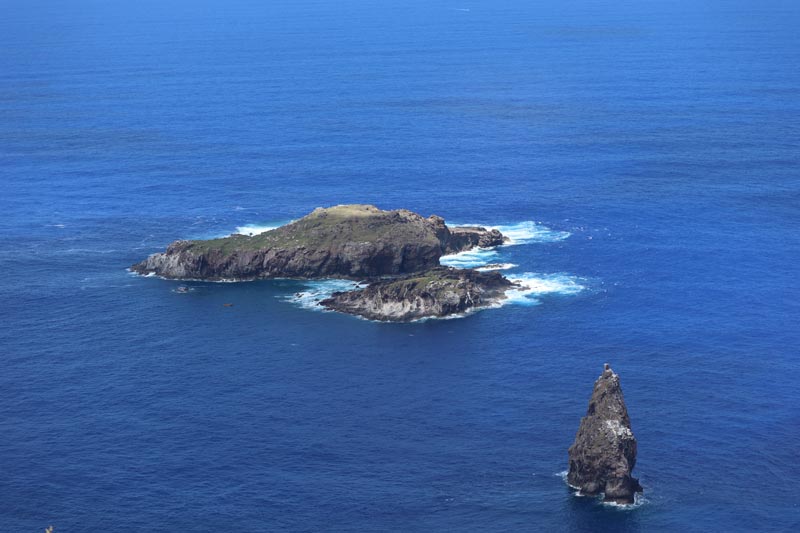
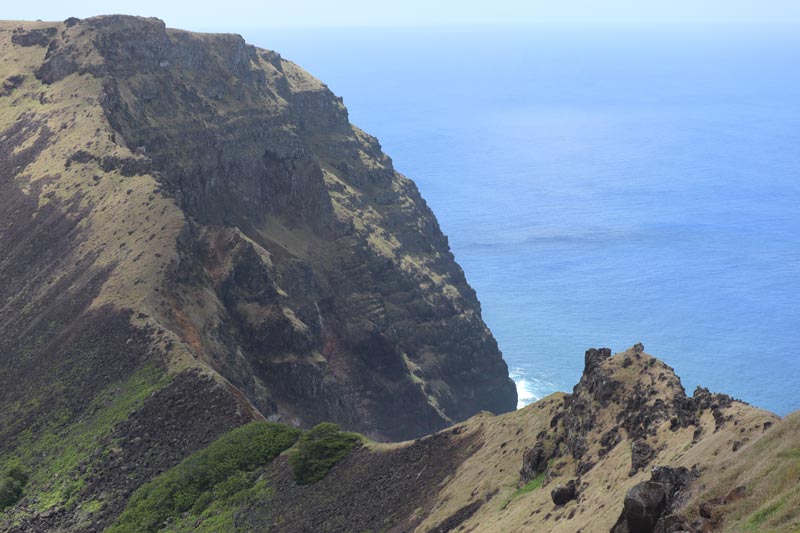
Visiting Orongo evokes flashes of what this annual festival must have looked like and, though it’s hard to spot these days, nearly 2,000 birdman petroglyphs serve as additional evidence to the lengths a society would go to when pushed to the edge. The best place to spot them is just before the trail begins to head back to the visitors center after the view of the islets.
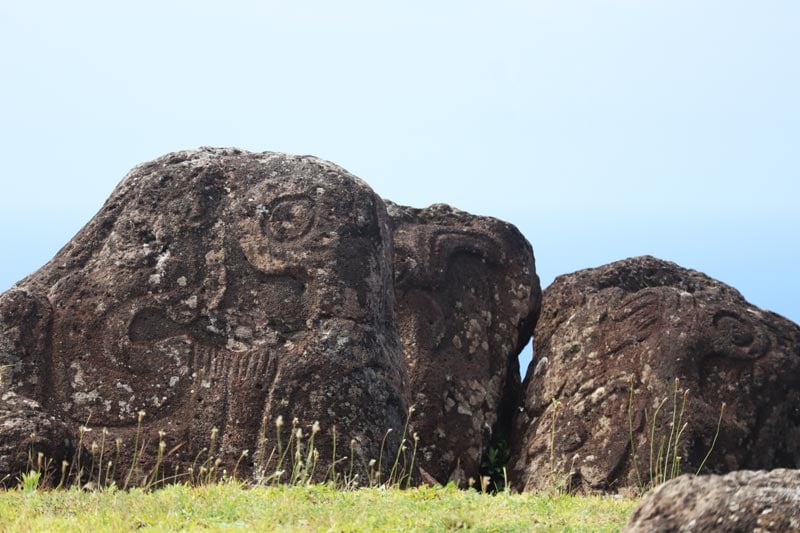
Rano Raraku
Together with Orongo, Rano Raraku is the second Easter Island site that can be visited just once. This is the “moai factory”, the quarry from which 97% of the nearly 1,000 moai were carved. Nearly 400 unfinished statues in various stages of completion are found along the slope of the crater, either damaged during early stages of transport to the various ahu or simply left abandoned by “the last shift”.
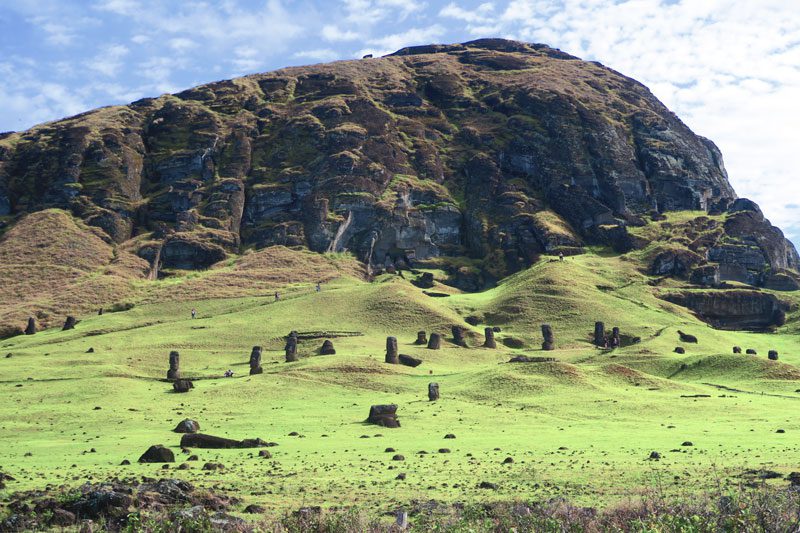

The visit to Rano Raraku is very thought-provoking, much more so than the visit to the variously completed ahu. It is here that you can picture the competing tribes carving in different sections of the crater, the sound of their toki stone hammers pounding the soft tuff for about two years until the nearly finished moai could be lowered down and prepared for transport.
Two paths are available to the visitor at Rano Raraku, the first brings you close to the moai, and the second heads up to the crater rim and down to a small lake (20 minutes return). Listed here are a few highlights.

At the time of updating this Easter Island travel guide (November 2024), it is no longer possible to hike to the crater rim.
Piro Piro Moai
One of the first moai statues on the path, the name of this moai means “bad smell” due to its enlarged nose. Legendary researcher Thor Heyerdahl and his team dug into the ground and discovered the total height of this moai to be 11 meters!

Hina Riru Moai
This moai and its neighbor are often featured in Easter Island photos. The head of Hina Riru moai (“crooked moai”) slightly tilts to the left, quite an unusual pose since the face usually remains aligned with the rest of the body.
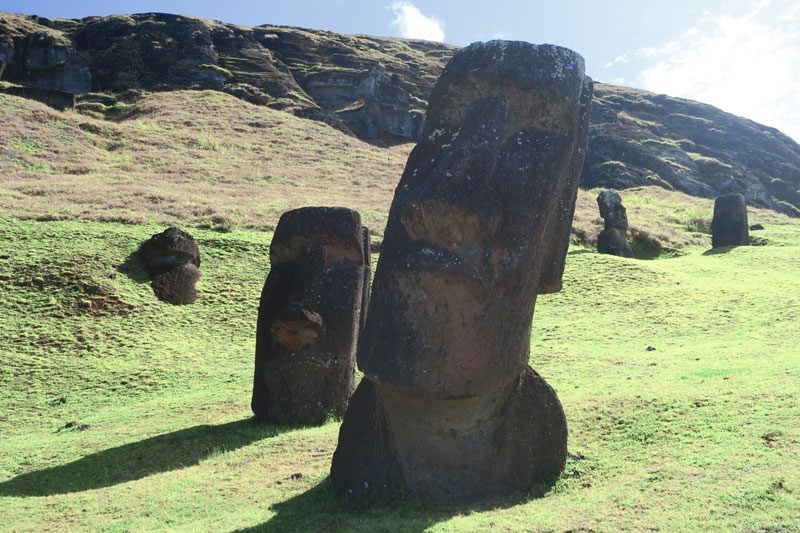
Te Tokanga
Known as “the giant” this unfinished moai is 22 meters tall and estimated to weigh 200 tons, the weight of a commercial airplane! It is the largest statue carved on Easter Island though serious doubts exist as to whether this moai could ever be transported or erected on an ahu.
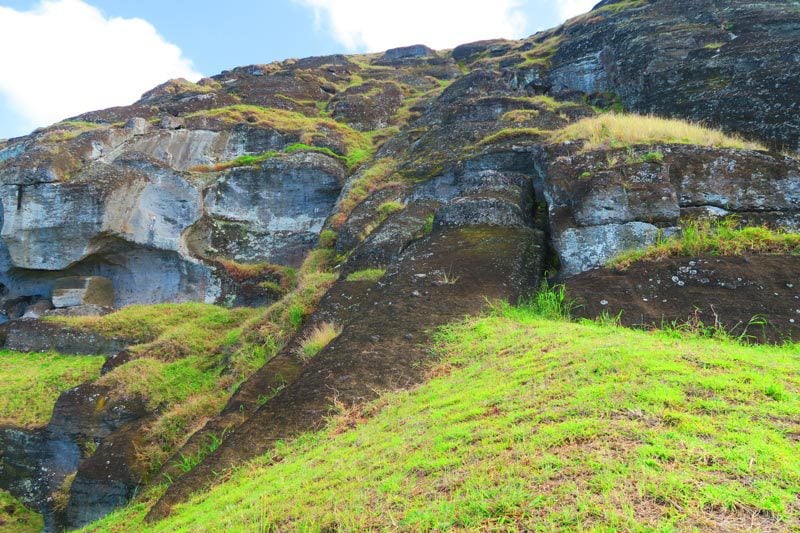
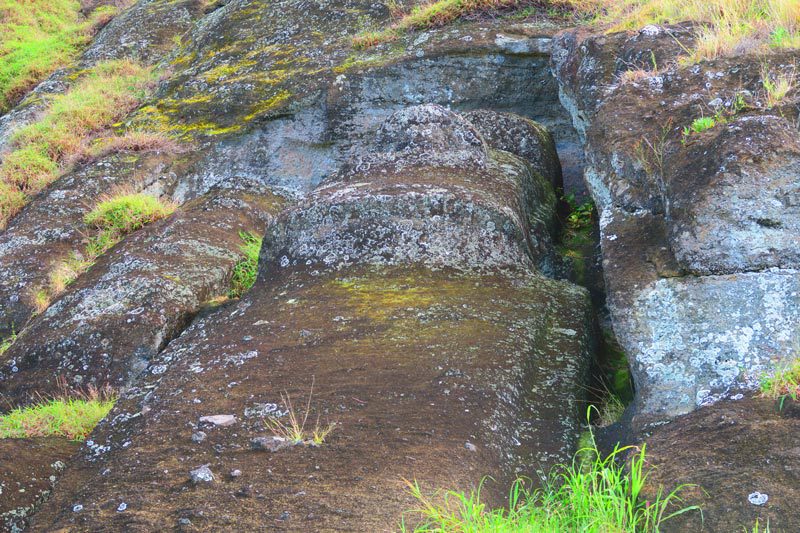
Ke Kona he Roa Moai
This moai features a carving of a European ship on its front, complete with three masts, square sails, and an anchor. It is believed that locals put the finishing touches on this moai after initial contact with Europeans.
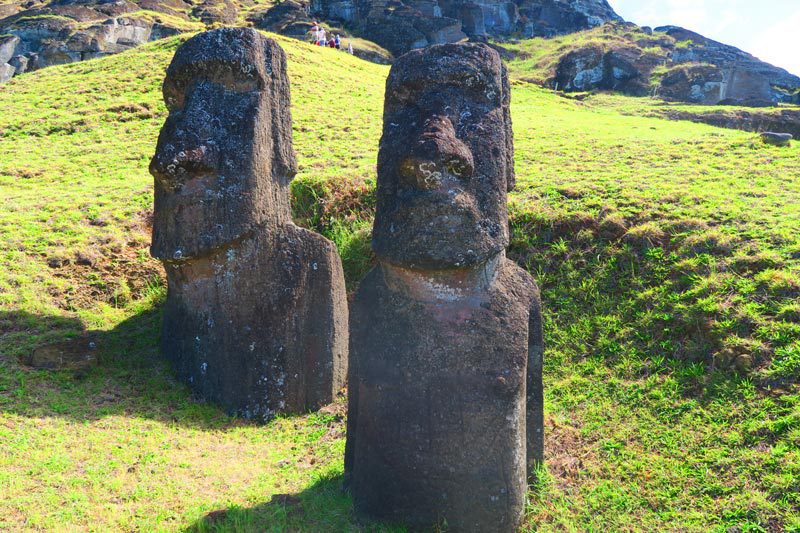

Tukuturi Moai
Quite out of place, this moai appears to be keeling, a position not depicted by all other moai statues. It resembles more of a Polynesian tiki than a Rapanui moai but in either case, you can catch incredible views of Ahu Tongariki from this very spot.
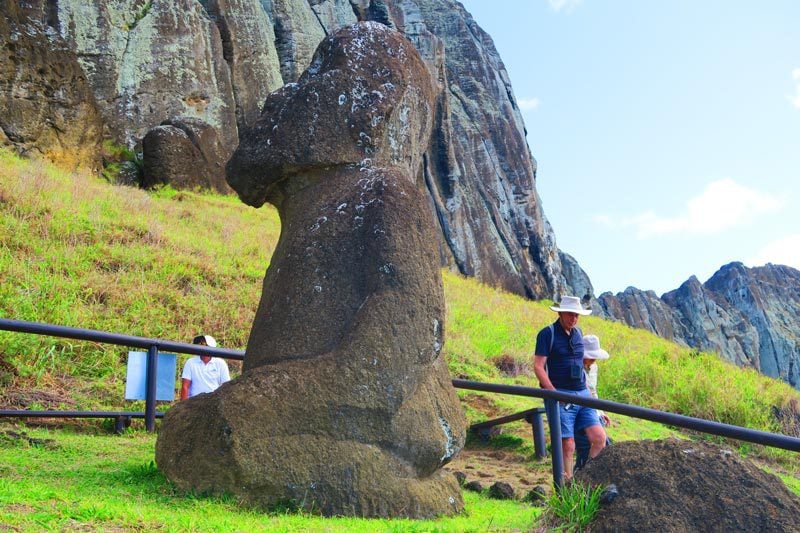
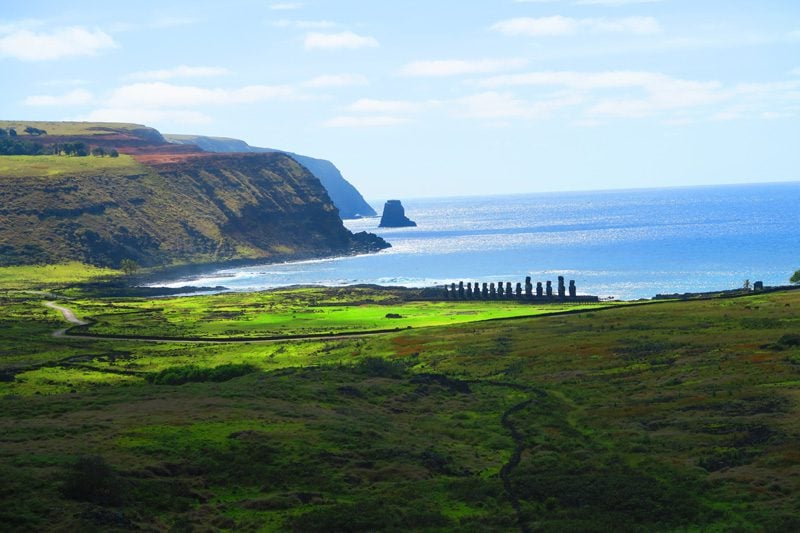
Rano Raraku Crater Lake
It takes about 10-15 minutes to reach the top of the crater from where you can see the small lake, about 700 meters in diameter and with water measuring 3-4 meters deep. As of my last visit to Easter Island in November 2024, hiking to the crater lake is no longer possible.
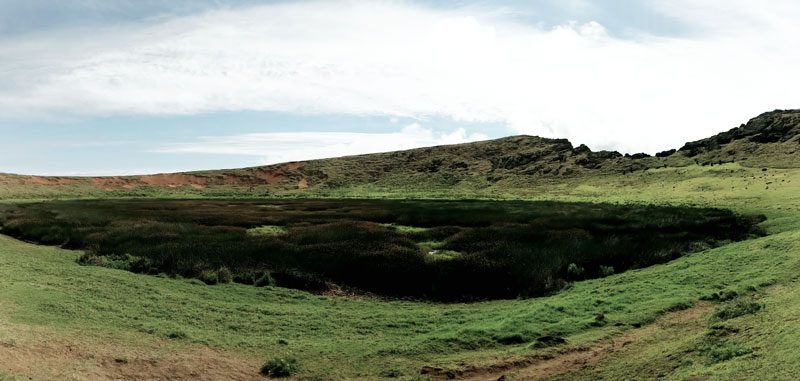

Ahu Tongariki
Of all the 300 temples on Easter Island, none are more majestic than Ahu Tongariki. Fifteen moai, the heaviest of which weighs 88 tons, adorn a stone platform spanning 160 meters. It is hard to fathom how the Rapanui could raise these monolithic beasts, especially since mighty cranes were needed in the restoration of Ahu Tongariki by the Japanese in 1994 following the 1960 tsunami that displaced the moai.

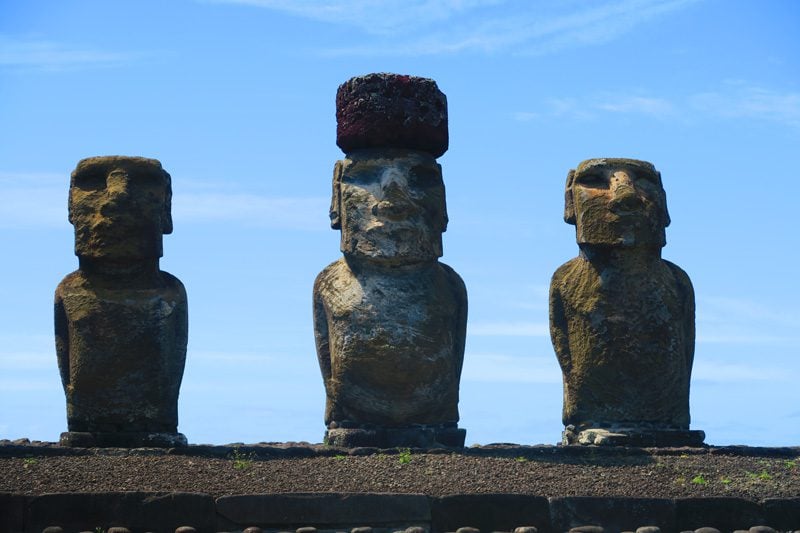
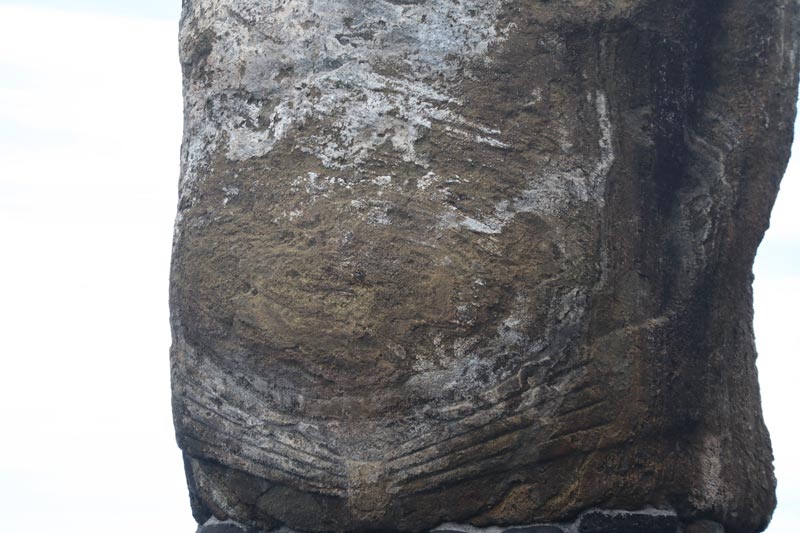
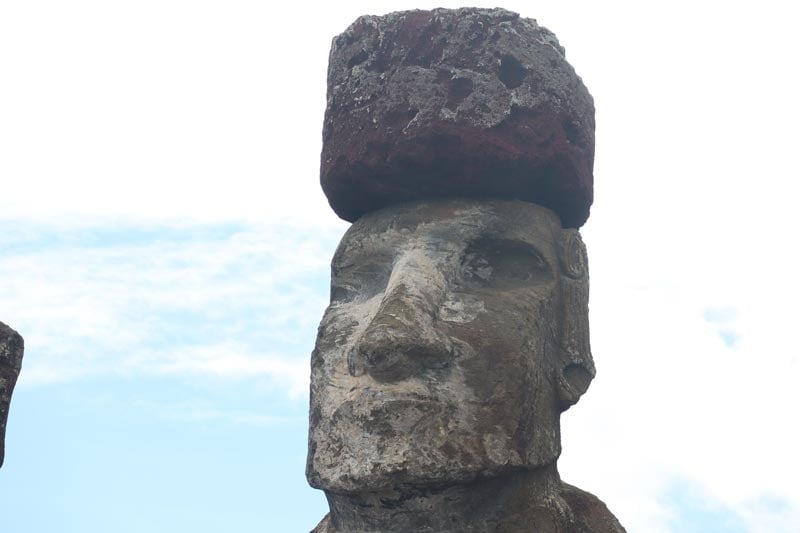

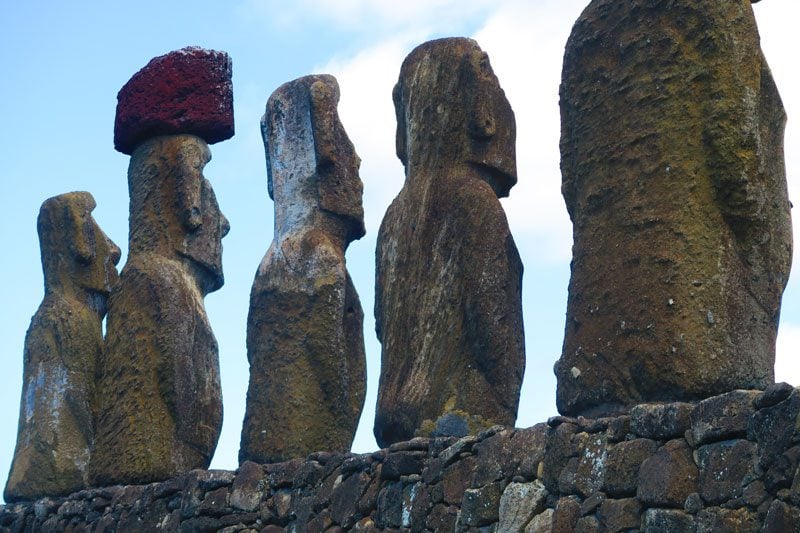
Ahu Tongariki is the best spot on Easter Island for watching the sunrise but in any event, its location is spectacular thanks to the rugged coastline behind the row of moai and the Poike volcano in the far distance.
Anakena Beach
Anakena is the best beach on Easter Island, a beautiful patch of white (and pink) sand fringed by palm trees brought over from Tahiti. Anakena is believed to be the spot where King Hotu Matua and his group of pioneers initially landed upon discovering the island.
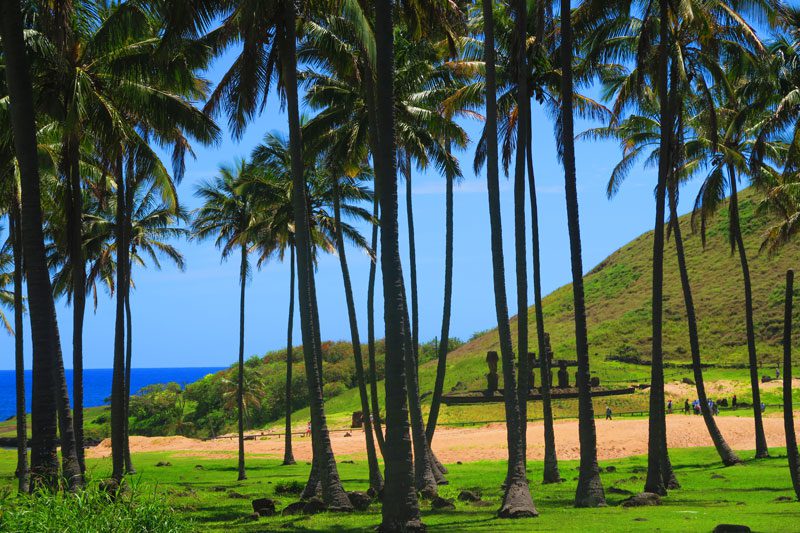

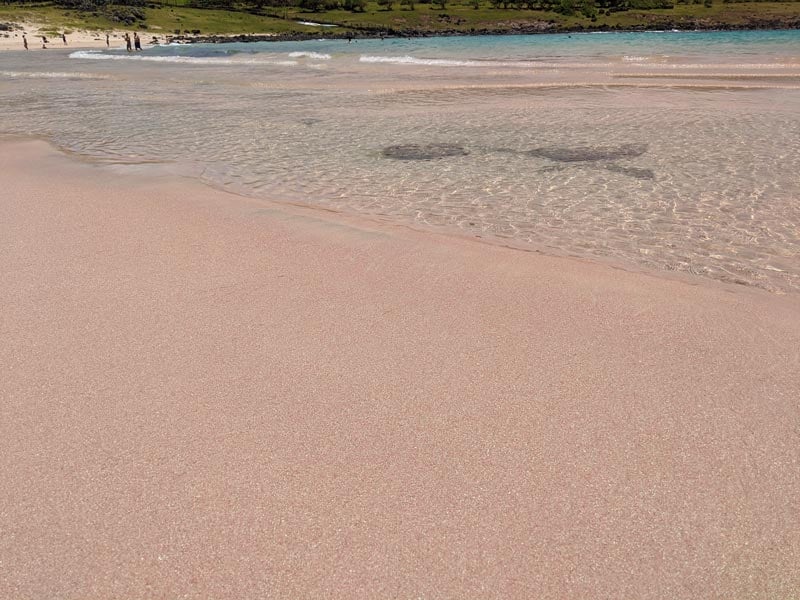
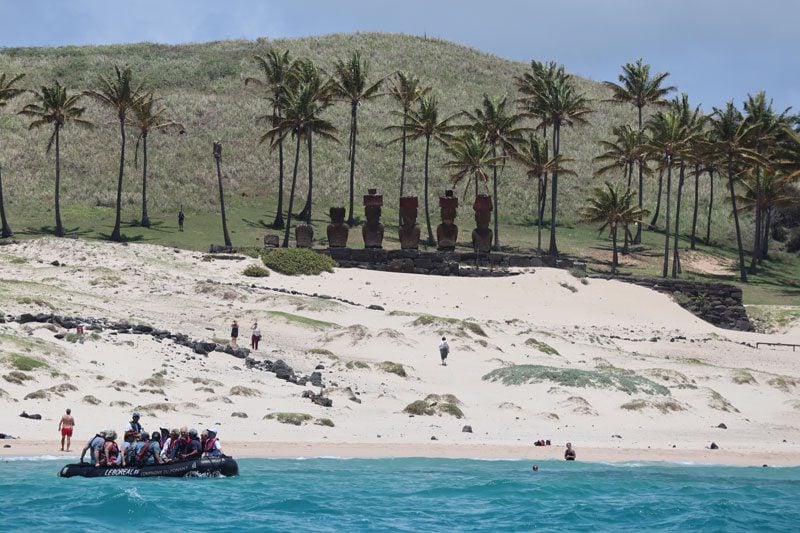

Anakena Beach is also home to Ahu Nau Nau, an impressive temple whose moai statues were preserved for decades or even more by soft sand that covered them.
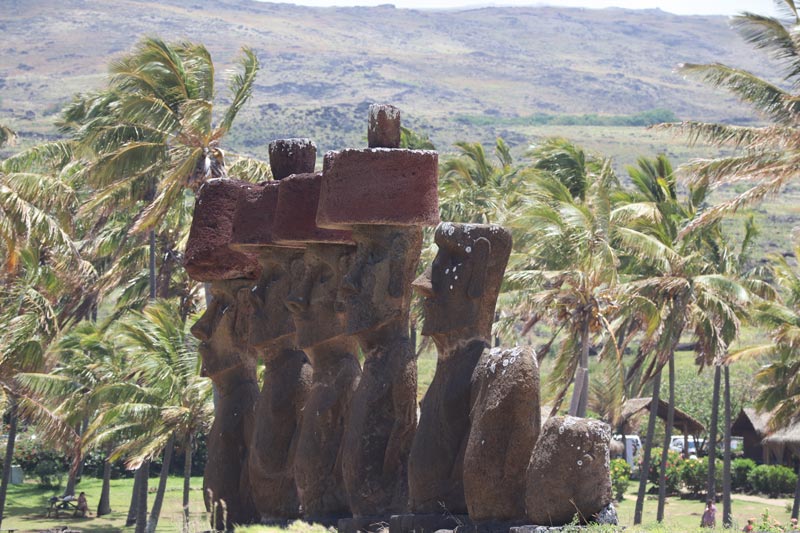
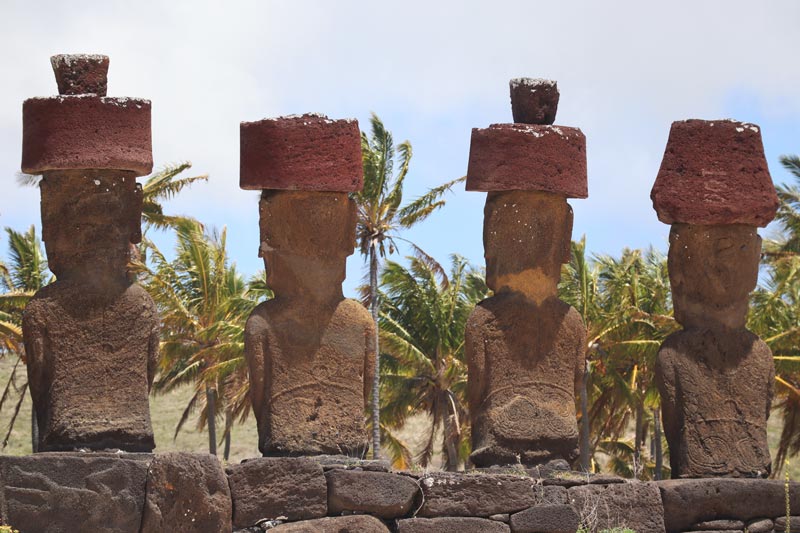

Right next to Ahu Nau Nau is the lone moai of Ahu Ature Huki, the first moai to be restored in Easter Island!

Though swimming is chilly year-round, Anakena is a popular place with the local residents of Easter Island and will get crowded (by Easter Island standards) over the weekend. Restaurants, souvenir shops, and public toilets make this an optimal stop for lunch or a lazy day under the sun.
Ahu Te Pito Kura
This unrestored ahu is home to the largest moai ever to be erected on a platform in Easter Island. Toppled sometime after 1838, it would have measured 10 meters in height! Next door to the ahu is a mysterious collection of round rocks which legend say are rocks brought by King Hotu Matua from the original homeland. Due to their composition, the rocks are known to play tricks on compasses and other instruments influenced by magnetic forces. Over the years, this collection of rocks has been called “the navel of the world”.
Papa Vaka
This is the best place on Easter Island to view petroglyphs, the largest of which is of a 12-meter long canoe!
Ahu Vinapu & Ahu Tahira
A complex of two temples on located on edge of the south coast of the island, where the airport runway ends.
Ahu Tahira
Home to five toppled moai and several pukao topknots scattered around, one in which a cavity was carved to collect rainwater. The main attraction here is a singular red column that rises in front of the ahu, possibly a rare female moai that was carved out of the same red scoria rock from which pukao topknots were carved.
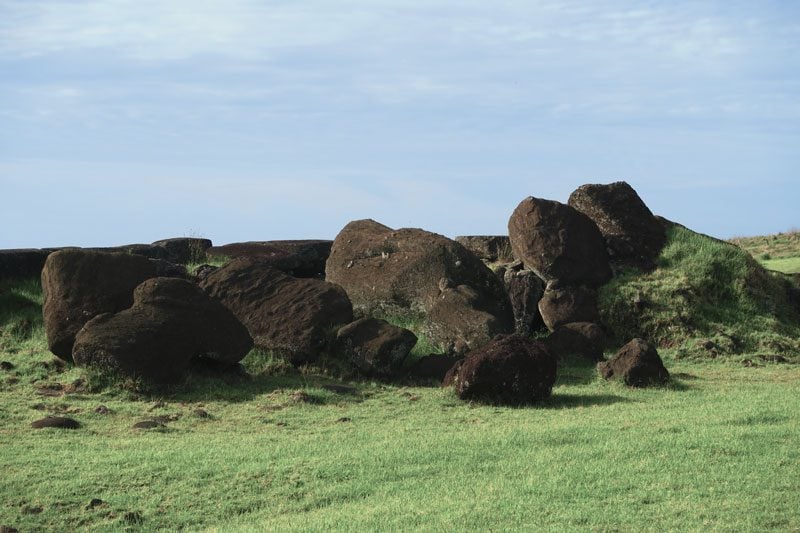
Ahu Vinapu
Features six toppled moai who would have been positioned to face the winter solstice. What is so special about this ahu is the back wall of its platform, slabs of basalt rock aligned with mathematical precision. This is the finest achievement of Rapa Nui stone and a cause for much speculation due to the stark resemblance to Inca walls seen in South America. Was this the result of knowledge sharing between Rapanui and Inca or was there an Inca presence on Easter Island? Yet another mystery! There’s also quite a nice view of the rugged coastline from this Ahu.

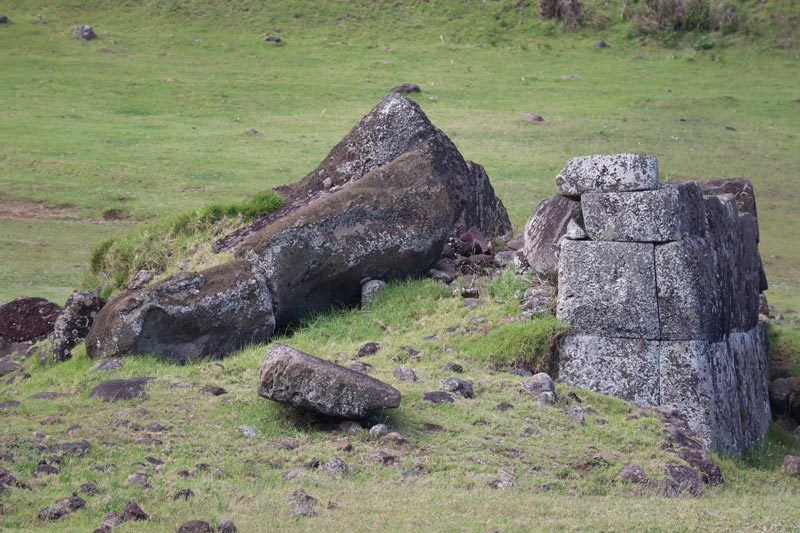
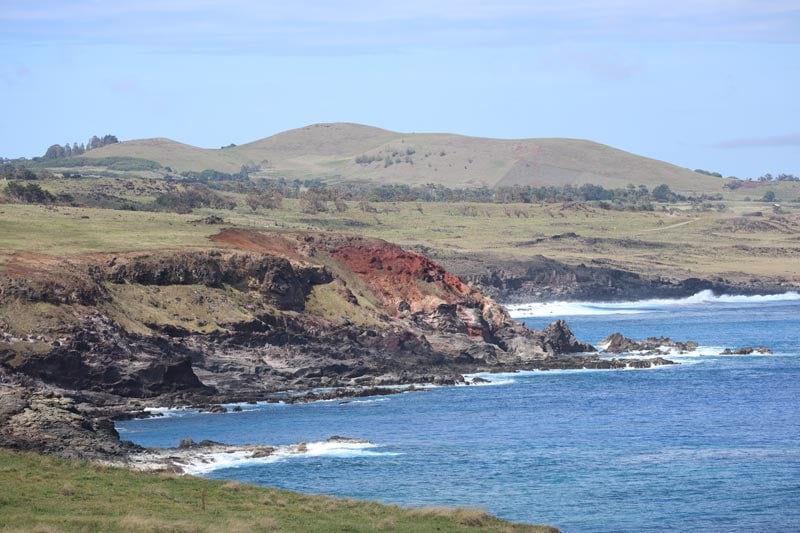
Ahu Vaihu
Another unrestored ahu, this time with eight large moai all face down after being violently toppled during intertribal warfare. In front of the platform is a circular area marked by stones and used in ancient times for family and communal rituals.

Within walking distance of the ahu is a “restored village” where you can see stone enclosures designed to protect crops from wind and salty sea spray, hare moa – stone enclosures with a small entrance used in the old days for housing chickens during the night, and hare paenga – “classic” Rapanui homes which resembled “upside down canoes”.
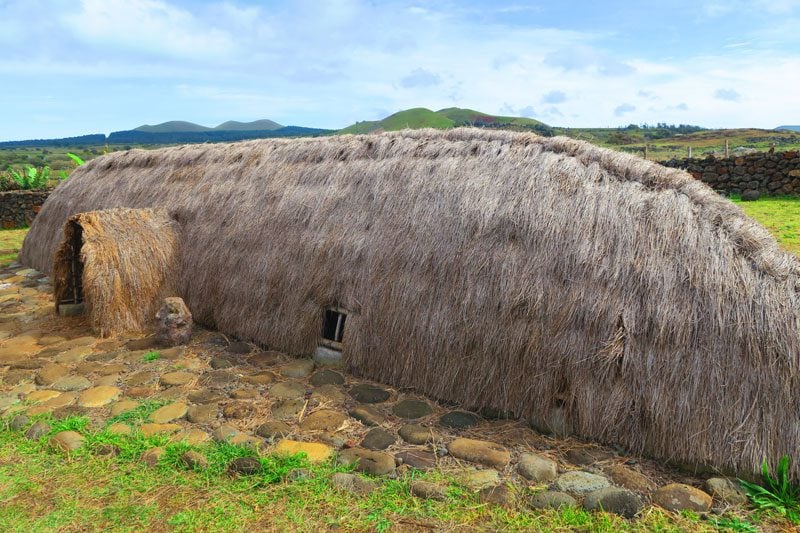
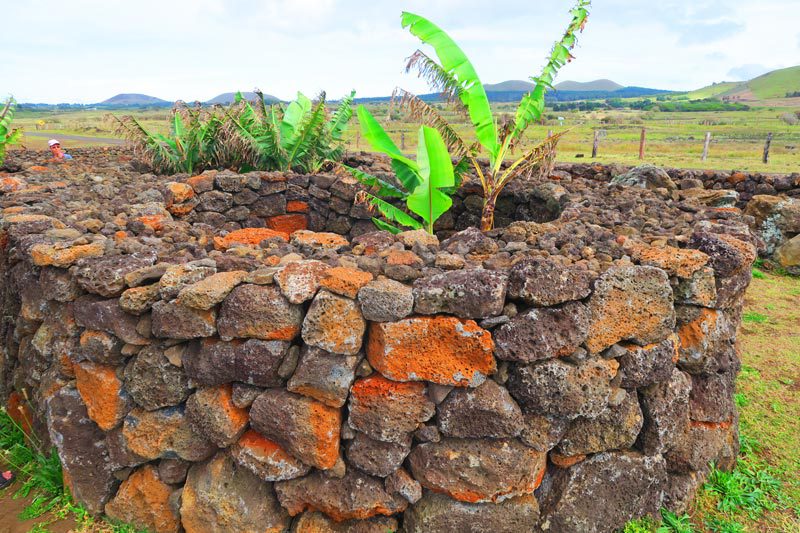
Hanga Poukura
A very photo stop (though there is a single moai that’s barely distinguishable) to admire large waves crashing the coast. You’ll also find lots of obsidian rock shining on the ground.


Ahu Te Peu
An isolated west coast ahu with plenty of surrounding evidence of village life in the form of chicken houses and the largest “boathouse” found on Easter Island measuring nearly 30 meters wide! The ahu is also on the trail of the epic north coast walk (see “hiking in Easter Island”).
Rapanui Cultural Shows
If you won’t be in Easter island during the February Tapati Festival, be sure to attend at least one Rapanui cultural dance show. At present, the finest show is put on by the Kari Kari dance group who hold shows several times per week. Mixing Tahitian and Rapanui dances to the sound of beating drums accompanied by ukulele and the occasional conch shell horn, do not miss this unique show! Here’s a sneak peek of the Kari Kari show.
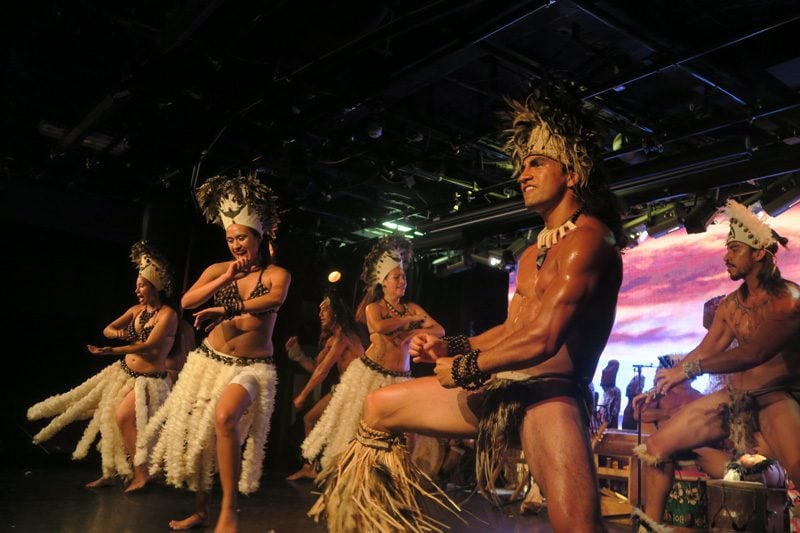
Hiking in Easter Island
While not as dramatic as other Polynesia islands, if you have an extra day, hiking is totally a worthwhile option. Easter Island features a number of DIY hikes, such as the hike to the summit of Mount Terevaka or from Hanga Roa to Rano Kau, but the more challenging hikes should not be attempted without a guide. These include the epic northern coast hike (no car access) and the remote hike in the Poike peninsula on the far side of the island. You’ll find lots of information on this link and I can recommend contacting Sammy Atan Tuki from Ruta Rapa Nui tours if you’re looking for a guide (satan@rutarapanui.com | rutarapanui@gmail.com | 56-984051093).

Scuba Diving in Easter Island
What the water off Easter Island lacks in term of tropical marine life, it certainly makes for with clarity. Scuba diving in Easter Island is another great activity for that “extra day” (together with hiking and horseback riding) and you’ll also get to see an underwater moai though it was certainly not placed there by the ancient Rapanui. Two of the island’s leading outfits are Atariki Diving Center and Mike Rapu, both located in the main pier in Hanga Roa.
Horseback Riding
If hiking ain’t your thing, consider hopping on a horse and exploring parts of Easter Island that cannot be reached by car. Visit this link for more information.

What’s Next?
I hope you found this Easter Island travel guide useful. Now it’s time to shape your own visit to Easter Island. Check out these additional resources and start planning!
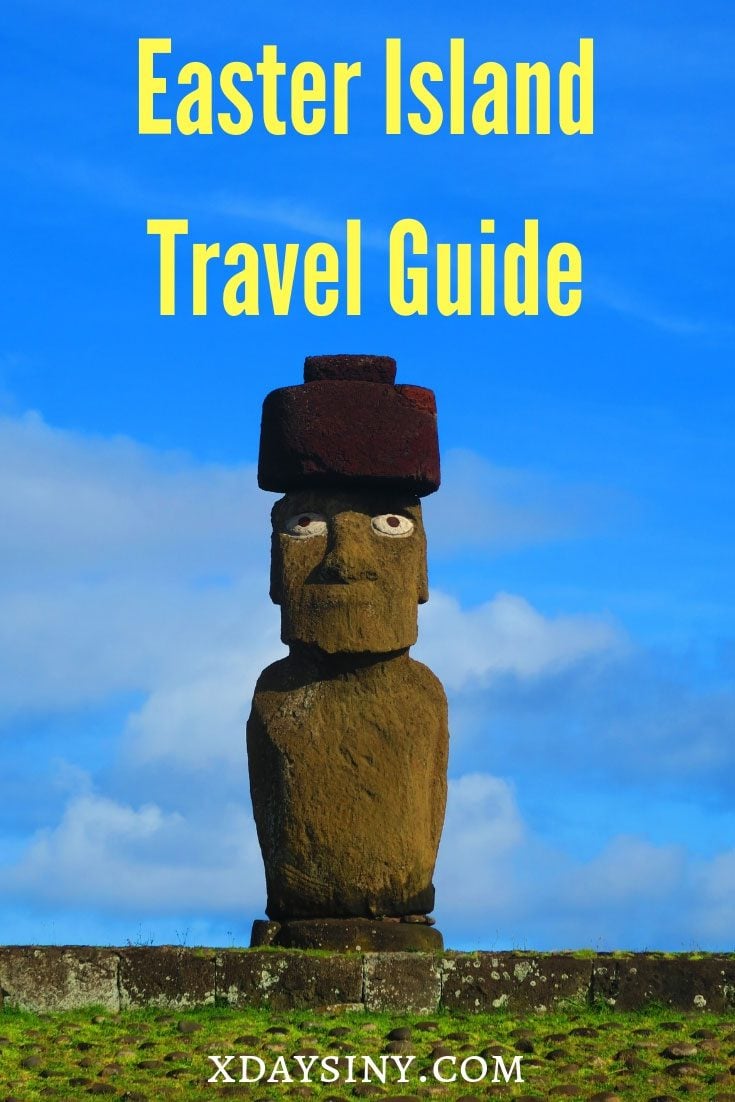

Pin These Images To Your Favorite Boards!

